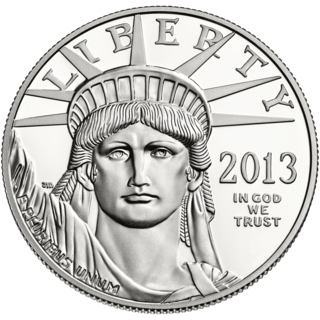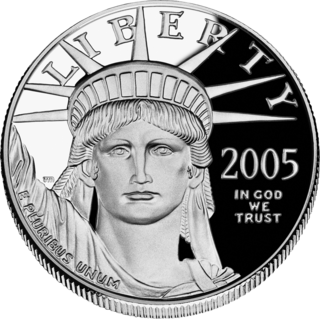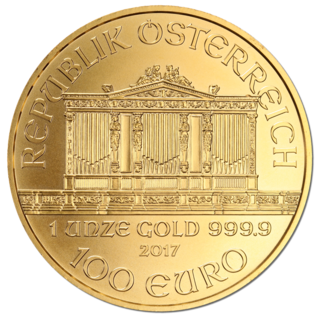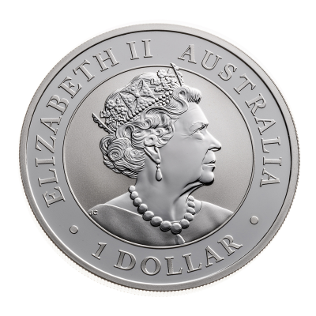
The Krugerrand is a South African coin, first minted on 3 July 1967 to help market South African gold and produced by Rand Refinery and the South African Mint. The name is a compound of Paul Kruger, the former President of the South African Republic, and rand, the South African unit of currency. On the reverse side of the Krugerrand is a pronking springbok, South Africa's national animal.

Precious metals are rare, naturally occurring metallic chemical elements of high economic value. Precious metals, particularly the noble metals, are more corrosion resistant and less chemically reactive than most elements. They are usually ductile and have a high lustre. Historically, precious metals were important as currency but are now regarded mainly as investment and industrial raw materials. Gold, silver, platinum, and palladium each have an ISO 4217 currency code.

The Royal Canadian Mint is the mint of Canada and a Crown corporation, operating under the Royal Canadian Mint Act. The shares of the Mint are held in trust for the Crown in right of Canada.

The American Gold Eagle is an official gold bullion coin of the United States. Authorized under the Gold Bullion Coin Act of 1985, it was first released by the United States Mint in 1986. Because the term "eagle" also is the official United States designation for the pre-1933 ten dollar gold coin, the weight of the bullion coin is typically used when describing American Gold Eagles to avoid confusion with the pre-1933 coins. This is particularly true with the 1/4-oz American Gold Eagle, which has a marked face value of ten dollars, the same as that of its predecessor.

The American Platinum Eagle is the official platinum bullion coin of the United States. In 1995, Director of the United States Mint Philip N. Diehl, American Numismatic Association President David L. Ganz, and Platinum Guild International Executive Director Jacques Luben began the legislative process of creating the Platinum Eagle. After over two years of work, the 99.95% fine platinum coins were released by the United States Mint in 1⁄10, 1⁄4, 1⁄2 and 1 troy oz denominations. In late 2008, the fractional denominations were discontinued, leaving only the one ounce denomination. The Platinum Eagle is authorized by the United States Congress, and is backed by the United States Mint for weight, content, and purity. Its obverse was designed by John Mercanti, and portrays the Statue of Liberty by Frédéric Auguste Bartholdi.

Britannia coins are British bullion coins issued by the Royal Mint in gold since 1987, in silver since 1997, and in platinum since 2018. The reverse of the coin patterns feature various depictions of Britannia, a feminine personification of the United Kingdom while the obverse features a monarch effigy with the legend around it.
The Canadian Gold Maple Leaf (GML) is a gold bullion coin that is issued annually by the Government of Canada. It is produced by the Royal Canadian Mint.

The Perth Mint is Australia's official bullion mint and wholly owned by the Government of Western Australia. Established on 20 June 1899, two years before Australia's Federation in 1901, the Perth Mint was the last of three Australian colonial branches of the United Kingdom's Royal Mint intended to refine gold from the gold rushes and to mint gold sovereigns and half-sovereigns for the British Empire. Along with the Royal Australian Mint, which produces coins of the Australian dollar for circulation, the Perth Mint is the older of Australia's two mints issuing coins that are legal tender.

The Manx Noble are platinum, gold or silver bullion coins distributed by the Isle of Man and minted by private companies. While platinum coins have been minted since the early 1800s, the Noble is the first platinum coin created for investors. The coins are not minted every year, but have an erratic schedule. Nobles are legal tender but they do not have a fixed face value; instead, like the Krugerrand or Mexico's Libertad, they are legal tender to the value of their precious metal content.

A gold bar, also known as gold bullion or a gold ingot, refers to a quantity of refined metallic gold that can be shaped in various forms, produced under standardized conditions of manufacture, labeling, and record-keeping. Larger varieties of gold bars, produced by casting molten metal into molds, are called ingots. Smaller bars are often created through minting or stamping from rolled gold sheets. Central banks typically hold the standard 400-troy-ounce Good Delivery gold bar in their gold reserves and it is widely traded among bullion dealers. Additionally, the kilobar, weighing 1,000 grams, and the 100-troy-ounce gold bar are popular for trading and investment due to their more manageable size and weight. These bars carry a minimal premium over the spot price of gold, facilitating small transfers between banks and traders. While most kilobars have a flat appearance, a preference for brick-shaped bars exists among some investors, particularly in Europe.

Platinum coins are a form of currency. Platinum has an international currency symbol under ISO 4217 of XPT. The issues of legitimate platinum coins were initiated by Spain in Spanish-colonized America in the 18th century and continued by the Russian Empire in the 19th century. As a form of currency, these coins proved to be impractical: platinum resembles many less expensive metals, and, unlike the more malleable and ductile silver and gold, it is very difficult to work. Several commemorative coin sets have been issued starting from 1978 and became popular among coin collectors. The major platinum bullion coins include the American Platinum Eagle, the Canadian Platinum Maple Leaf, the Australian Platinum Koala, the Isle of Man Noble, the Chinese Platinum Panda, the Austrian Vienna Philharmonic and several series by the Soviet Union and later by the Russian Federation.
The Canadian Silver Maple Leaf is a silver bullion coin that is issued annually by the Government of Canada since 1988. It is produced by the Royal Canadian Mint.
The Canadian Platinum Maple Leaf is the official bullion platinum coin of Canada. First issued by the Royal Canadian Mint in 1988, it was available until 2002 in five different denominations, all of which are marked as containing .9995 pure platinum. The bullion coin was partly reintroduced in 2009 in the form of the 1 troy ounce denomination in .9999 purity, featuring a new portrait of Queen Elizabeth II on the obverse. The coins have legal tender status in Canada, but as is often the case with bullion coins, the face values of these coins is lower than the market price of the material they are made from.
Traditionally, Olympic coins are numismatic coins. However, several host countries minted so many coins – particularly silver ones – that their value has become just slightly above the value of their metal content. Coins for the 1976 Montreal, 1984 Los Angeles, and 1988 Seoul are generally considered to fall into that category.

The Silver Kookaburra is a silver bullion coin originating from Australia, and produced at the Perth Mint starting in 1990. The coins were .999 fine silver until the 2018 edition, which increased in purity to .9999 silver. While the obverse of the coin always depicts the reigning monarch--Queen Elizabeth II during her reign and now features King Charles III, the reverse side changes every year, always featuring a kookaburra, a bird native to Australia. Due to the yearly design change and limited production of the one-ounce coins, they have higher collectible value than some other bullion coins. The Perth Mint, generally, ships the coins in individual plastic capsules. One-ounce coins ship in shrink wrap rolls of 20, with 5 rolls in each box of 100. They are minted in four sizes; 1,000 g, 10, 2 and 1 troy ounces.

A gold coin is a coin that is made mostly or entirely of gold. Most gold coins minted since 1800 are 90–92% gold (22‑karat), while most of today's gold bullion coins are pure gold, such as the Britannia, Canadian Maple Leaf, and American Buffalo. Alloyed gold coins, like the American Gold Eagle and South African Krugerrand, are typically 91.7% gold by weight, with the remainder being silver and copper.

The Vienna Philharmonic, often shortened to Philharmonic, is a bullion coin of gold, silver, or platinum produced by the Austrian Mint. The coin is named for the Vienna Philharmonic orchestra, which inspired the design of both sides. It was introduced in 1989, as a one-troy ounce (ozt) gold coin with a face value of 2,000 Austrian schillings. It is one of the world's best selling bullion coins. In 2002, with the adoption of the euro currency, the nominal value of the one-ounce coin was changed to 100 euros. In 2008, the Mint introduced a one-ounce silver version of the coin with a nominal value of 1.5 euros. The silver coin is also one of the top selling bullion coins, ranked third in 2013. In 2016, the mint introduced a one ounce platinum coin with a face value of 100 euros.

The American Palladium Eagle is the official palladium bullion coin of the United States. Each coin has a face value of $25 and is composed of 99.95% fine palladium, with 1 troy ounce actual palladium weight.

The Silver Koala Bear is a silver coin originating from Australia and produced at the Perth Mint. While the obverse of the coin always depicts Queen Elizabeth II of Australia, the reverse side changes every year, always featuring a koala, a marsupial native to Australia.

The Silver Kangaroo is a silver coin originating from Australia and produced at the Perth Mint. This is a bullion coin meant for investment in silver. An Australian silver kangaroo coin, produced at the Royal Australian Mint (RAM), is collected for its numismatic value. The obverse of the coin always depicts Queen Elizabeth II. The reverse side features a red kangaroo jumping. Unlike the Australian silver koala and silver kookaburra coins, the reverse image does not change every year. The obverse image on the RAM silver coin does change every year. The mintage every year is unlimited, unlike the koala and kookaburra coins which have a maximum mintage of 300,000 and 500,000 respectively. No special editions or privy marks have appeared for the one-ounce bullion coin.
the face value of 1991 tenth oz platinum Koala is Fifteen Dollars.
















